|
April 26,
2001
Inland Trip, Ecuador - Quito & the Andean Highlands
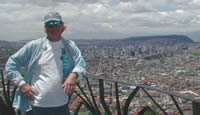 Inland
Trip, Ecuador - Quito & the Andean Highlands The past week was
the first full-fledged dose of tourismo for the Two Captains since
our junket to Angel Falls in Venezuela last July. No wonder people
only vacation for a week at a time. It's work! Seriously, though,
we had a simply wonderful time. Ecuador is a delightful country.
"You find Ecuador tranquile, no?" the people repeatedly
ask us. Compared to its neighbor Colombia, Ecuador is indeed tranquil….at
least now that the furor over the "dollarization" of their
economy and some resultant price increases has died down. Inland
Trip, Ecuador - Quito & the Andean Highlands The past week was
the first full-fledged dose of tourismo for the Two Captains since
our junket to Angel Falls in Venezuela last July. No wonder people
only vacation for a week at a time. It's work! Seriously, though,
we had a simply wonderful time. Ecuador is a delightful country.
"You find Ecuador tranquile, no?" the people repeatedly
ask us. Compared to its neighbor Colombia, Ecuador is indeed tranquil….at
least now that the furor over the "dollarization" of their
economy and some resultant price increases has died down.
We left Bahia
promptly at 8 am Wednesday morning, and I rode most of the eight-hour
, 10,000-foot ascent to Quito with my face plastered to the window
like a little kid. Inland of Bahia the river edge has been cordoned
off into ponds for shrimp aquaculture. The Lonely Planet Guide blasts
the destruction of the mangrove environments this has wrought, but
as catfish farmers we found it pretty interesting. The next major
stage was a swampy plateau that brought to mind images of southeast
Asia, and indeed many of the cane houses were built on stilts above
standing water that may or may not have been planted in rice. Next
came a land of very steep convoluted hills covered in grassland
and topped with luck by a single palm tree. Then a big agricultural
plateau where we saw trucks and stands full of fruit and vegetables.
And finally the long climb up into and over the Andes themselves.
I don't know what was more amazing: the mountains, the road, or
the amount of heavy commercial trucking - like large flatbed trucks
of cement blocks, not to mention all the busses - going both ways…and
passing!… on this serpentine, two-lane highway! We went over
the top in the clouds, and descended out of them again into Ecuador's
central valley, dubbed the Avenue of the Volcanoes, down which runs
the Pan American Highway.
Quito is really
one of the most amazing cities you will ever lay eyes on. Even though
it is 2850 meters above sea level (about 9400 feet), huge mountains
loom over it. Imagine a bunch of woks crowded together, and you'll
have an idea of the steep bowl-like formations of its urban sprawl.
And, then, when that sprawl ends, picture orderly fields continuing
on towards the summits! Come to think of it, make a perimeter of
upside-down woks, and you'll have an idea of the immense flanks
of the surrounding volcanoes!
The bus station
is in Old Quito, which is packed especially tight into some gorges.
Throughout it are colonial buildings of great historical significance
and charm. However, old Quito is where most reports of pick-pocketing
and mugging take place, and our desire to avoid THAT negative experience,
along with a mutual indifference about historical buildings, made
the bus station the only part of old Quito we spent any time in.
We promptly grabbed a cab (which over-charged us handsomely before
we discovered they have two settings on their meters!) to Hostel
Nassau, our B&C recommended hostel, in a part of New Quito known
informally as "Gringolandia." Gringolandia is a seventy
(or so) square-block area of hostels, cosmopolitan restaurants (something
other than beef and ceviche!), T-shirt shops, tour agencies, and
Internet cafés in which the population is mostly Euro-American
and younger than thirty!
One more thing
about Quito. The guides describe its high mountain climate as perpetually
spring-like. Well, on a bright sunny day it's delightful, but overcast
after a thunderstorm as it was upon our arrival, it can get downright
chill. Brrrrr!
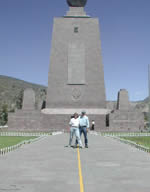 Fortunately,
the next morning dawned bright and sunny for our excursion to Mitad
del Mundo. This is the site where a French expedition in the late
18th century madethe measurements that determined the location of
the Earth's equator, as well as the fact that the Earth isn't exactly
round, but flattened at the poles, and, incidentally laid the foundations
of the metric system. It is also one of the few places in the world
you can actually stand on the equator, as much of the rest of Mother
Earth's middle is lost in jungle or ocean. The monument at Mitad
del Mundo takes you up in an elevator to a lookout that gives a
good view of the surrounding territory, the landscape of which is
pretty much a scrubby desert. Descent inside the monument winds
down through exhibits of all the various indigenous peoples - their
customs, their history, their special crafts and their distinctive
dress (they prefer "indigenes" to "Indians")
- that make Ecuador so culturally diverse. This would have been
really interesting if more than four of the twenty or thirty placards
had been in English! A side exhibit at the park displayed a current
scientific/archaeological research project being done that suggests
that a very early pre-Inca people had located the "Center of
World" even more accurately than the French, about 800 yards
away. This culture had built temples on sites precisely equidistant
from one another at angles of 23 ½ degrees, accurately lining
up the declination of the winter and summer solstices in the geometric
star pattern that we see depicted over and over in traditional weavings.
The description of this project and its findings was presented in
a rapid-fire delivery by a multi-lingual scholar who gave the same
spiel all over to the next couple in French! A piece of geographic
trivia this fellow pointed out was that Ecuador's highest volcano
Chimborazo, albeit slightly lower than Everest in height above sea-level
is actually higher when measured from the center of the Earth, since
the Earth is fatter at the Equat After Mitad del Mundo, our taxi
driver convinced us to let him show us La Virgin of Quito (our initially
well-bargained fare now going down the tubes!). This is a monument
in the fashion of the Statue of Liberty that was given to Quito
from Spain. The hollow figure sports a crown of stars, eagle's wings
(that give her an uncomfortable-looking hunched posture) and a chained
dragon…something Biblical. While smaller than Ms Liberty, the
Virgin is set high up on a hill above the Old City, which gave us
a fabulous 360-degree panorama of the entire Quito metropolitan
area from her observation platform. Would that we'd dared to go
back at night! Fortunately,
the next morning dawned bright and sunny for our excursion to Mitad
del Mundo. This is the site where a French expedition in the late
18th century madethe measurements that determined the location of
the Earth's equator, as well as the fact that the Earth isn't exactly
round, but flattened at the poles, and, incidentally laid the foundations
of the metric system. It is also one of the few places in the world
you can actually stand on the equator, as much of the rest of Mother
Earth's middle is lost in jungle or ocean. The monument at Mitad
del Mundo takes you up in an elevator to a lookout that gives a
good view of the surrounding territory, the landscape of which is
pretty much a scrubby desert. Descent inside the monument winds
down through exhibits of all the various indigenous peoples - their
customs, their history, their special crafts and their distinctive
dress (they prefer "indigenes" to "Indians")
- that make Ecuador so culturally diverse. This would have been
really interesting if more than four of the twenty or thirty placards
had been in English! A side exhibit at the park displayed a current
scientific/archaeological research project being done that suggests
that a very early pre-Inca people had located the "Center of
World" even more accurately than the French, about 800 yards
away. This culture had built temples on sites precisely equidistant
from one another at angles of 23 ½ degrees, accurately lining
up the declination of the winter and summer solstices in the geometric
star pattern that we see depicted over and over in traditional weavings.
The description of this project and its findings was presented in
a rapid-fire delivery by a multi-lingual scholar who gave the same
spiel all over to the next couple in French! A piece of geographic
trivia this fellow pointed out was that Ecuador's highest volcano
Chimborazo, albeit slightly lower than Everest in height above sea-level
is actually higher when measured from the center of the Earth, since
the Earth is fatter at the Equat After Mitad del Mundo, our taxi
driver convinced us to let him show us La Virgin of Quito (our initially
well-bargained fare now going down the tubes!). This is a monument
in the fashion of the Statue of Liberty that was given to Quito
from Spain. The hollow figure sports a crown of stars, eagle's wings
(that give her an uncomfortable-looking hunched posture) and a chained
dragon…something Biblical. While smaller than Ms Liberty, the
Virgin is set high up on a hill above the Old City, which gave us
a fabulous 360-degree panorama of the entire Quito metropolitan
area from her observation platform. Would that we'd dared to go
back at night!
On Friday morning
we boarded another bus, this time for a two-hour trip east and north
out of Quito. Initially the landscape was more mountainous desert
cut by deeply etched gorges that the bus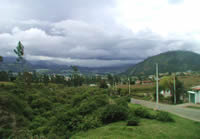 had to negotiate, but then, abruptly we came over a rise into lush
green farm land. The central purpose to this excursion was the world-famous
Saturday morning market in Otavalo, but, based on Cindy & Baker's
recommendations, we had decided to stay in the nearby provincial
capital of Ibarra. Both these communities, along with a string of
others, have grown up on the lower flanks of the majestically Buddah-like
extinct volcano Imbaburra (4609m), which we learned later the Indians
call the Sleeping Father. We thought, as the bus pulled in to Ibarra,
that we had made a mistake, for it looked like just a crowded noisy
town. We grew more worried after B&C's recommended hostel was
full. We needn't have fretted. There are probably several dozen
hostels in Ibarra. The one our cab driver took us to was the Hostel
Madrid, where we were welcomed in English by a young girl who'd
spent a year as an au pair in North Carolina. There we got a nice
bright room (like our Quito hostel @$5 pp/nite!) only this one with
a TV! We got settled in, had a nice "almuerzo" in the
downstairs restaurant (the only restaurant we've been in with cloth
napkins in lieu of the notably puny paper napkings endemic to this
country!) and then set out boldly on our tourist "To Do"
list. Unexpectedly this was the beginning of a very special sequence
of events.
had to negotiate, but then, abruptly we came over a rise into lush
green farm land. The central purpose to this excursion was the world-famous
Saturday morning market in Otavalo, but, based on Cindy & Baker's
recommendations, we had decided to stay in the nearby provincial
capital of Ibarra. Both these communities, along with a string of
others, have grown up on the lower flanks of the majestically Buddah-like
extinct volcano Imbaburra (4609m), which we learned later the Indians
call the Sleeping Father. We thought, as the bus pulled in to Ibarra,
that we had made a mistake, for it looked like just a crowded noisy
town. We grew more worried after B&C's recommended hostel was
full. We needn't have fretted. There are probably several dozen
hostels in Ibarra. The one our cab driver took us to was the Hostel
Madrid, where we were welcomed in English by a young girl who'd
spent a year as an au pair in North Carolina. There we got a nice
bright room (like our Quito hostel @$5 pp/nite!) only this one with
a TV! We got settled in, had a nice "almuerzo" in the
downstairs restaurant (the only restaurant we've been in with cloth
napkins in lieu of the notably puny paper napkings endemic to this
country!) and then set out boldly on our tourist "To Do"
list. Unexpectedly this was the beginning of a very special sequence
of events.
First stop was
the village of Cotacachi. We have to take a moment here to admit
that the tourist "To Do" list for this part of the world
almost reads like a shopping list to a bunch of outlet malls. The
Indians of these highlands have specialized in a variety of crafts,
and these specialties seem to get concentrated in particular towns.
Therefore, to go to Cotacachi means you are going to look at leather
goods. Leather is not something particularly practical for a couple
of tropically-inclined yachties, and we really are talking LEATHER:
jackets, pants, belts, bags, briefcases, shoes, hats (tried, but
failed, to talk Don into a suede ball cap!) PLUS a whole range of
goods made with leather and woven or knit combinations, shawls,
dresses, vests, more bags….. It was endless! Still we enjoyed
wandering the streets, and Don did buy a horse-hair hatband for
his Panama hat plus a sweater jacket of llama wool (which he has
worn non-stop since!) while I bought a CD of Andean folk music.
Back in Ibarra,
Don felt he deserved a cold beer so we went looking for the El Encuentro,
a bar recommended in the Lonely Planet Guide. How convenient that
it turned out to be around the corner from our hostel. The bar is
in an inner courtyard, with rooms filled with antique ranching equipment
jigsawed in around the center. If we haven't mentioned it before,
the beer, called simply Pilsener, comes in over-size 600ml bottles
for between 65 cents and a $1@. We were racking up a few when a
group of young professionals arrived at the table near us. One of
their party, hearing English, instantly came over and introduced
himself. An English teacher at the college, despite never having
been to an English-speaking country, Victor was keen on taking advantage
of the chance to speak with us. But, the cultural exchange was hardly
one way. To start with he invited us to a concert that night. We
went expecting something traditional, possibly Spanish, perhaps
even classical, but were astounded to get a performance of quite
progressive original New Age style music, as well as several modern
dance performances. We parted late with a pledge to come meet his
family the next afternoon.
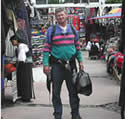 Saturday
morning dawned very early for the 2Cs and apparently too early for
any Ibarra breakfast establishment, so, coffee-less we boarded yet
another bus (hopefully, you are getting the very valid impression
that public transportation is well-developed in Ecuador) back to
Otavalo. We were rewarded by stumbling on the best breakfast we
had anywhere in Ecuador at a cheerful café a block from the
market. Good thing Don was fortified, because the market could have
otherwise been overwhelming. Hundreds of stalls teeming with the
handicrafts of local Indians fill a large open square and spill
onto adjoining side streets. The Otalaveño Indians in particular
are renowned for their weaving and there was stall after stall of
sweaters, hats, gloves, socks, bags, purses, ponchos, blankets,
hammocks, and wall hangings. There were tiny painted boxes, dolls,
bracelets, wood carvings, embroidered shirts, music instruments
and on and on and on! The sheer volume of wool (from llamas as well
as sheep) was awesome. The people selling were as fascinating as
what was being sold. The men wear white pants that stop mid-calf
with ponchos on top, a long braid down their back and the ubiquitous
felt hat. The women wear a cream wool full-length skirt with a second
black or navy skirt over it, embroidered blouses, shawls, a neck-full
of gold beads and either the felt hat or a elaborately folded headscarf.
These are just the Otalaveños; there were probably another
dozen groups represented each with their own distinctive dress.
Babies were everywhere, often strapped to their back with a crisscross
of sheeting, sometimes left to amuse themselves in a pile of product,
and quite often nursing openly! We tried very hard to peruse all
the offerings before any buying took place, but suffice it to say
it to say we surely have at least one of everything! And although
we tried hard to bargain, I'm sure we paid half-again what we needed
to. The good thing about this is the stuff is so cheap, everybody
thinks they did well by the deal. Saturday
morning dawned very early for the 2Cs and apparently too early for
any Ibarra breakfast establishment, so, coffee-less we boarded yet
another bus (hopefully, you are getting the very valid impression
that public transportation is well-developed in Ecuador) back to
Otavalo. We were rewarded by stumbling on the best breakfast we
had anywhere in Ecuador at a cheerful café a block from the
market. Good thing Don was fortified, because the market could have
otherwise been overwhelming. Hundreds of stalls teeming with the
handicrafts of local Indians fill a large open square and spill
onto adjoining side streets. The Otalaveño Indians in particular
are renowned for their weaving and there was stall after stall of
sweaters, hats, gloves, socks, bags, purses, ponchos, blankets,
hammocks, and wall hangings. There were tiny painted boxes, dolls,
bracelets, wood carvings, embroidered shirts, music instruments
and on and on and on! The sheer volume of wool (from llamas as well
as sheep) was awesome. The people selling were as fascinating as
what was being sold. The men wear white pants that stop mid-calf
with ponchos on top, a long braid down their back and the ubiquitous
felt hat. The women wear a cream wool full-length skirt with a second
black or navy skirt over it, embroidered blouses, shawls, a neck-full
of gold beads and either the felt hat or a elaborately folded headscarf.
These are just the Otalaveños; there were probably another
dozen groups represented each with their own distinctive dress.
Babies were everywhere, often strapped to their back with a crisscross
of sheeting, sometimes left to amuse themselves in a pile of product,
and quite often nursing openly! We tried very hard to peruse all
the offerings before any buying took place, but suffice it to say
it to say we surely have at least one of everything! And although
we tried hard to bargain, I'm sure we paid half-again what we needed
to. The good thing about this is the stuff is so cheap, everybody
thinks they did well by the deal.
Despite being
laden with our purchases we hopped off the bus short of home to
take in the tourist luncheon featured at the Hostelria Chorlavi.
This is a working Hacienda which doubles as an upscale resort for
wealthy Ecuadorians. There's a pool, tennis court, and stables,
and all the ground between the buildings is planted for home-grown
vegetables. On Saturdays after the market they feature a traditional
band and young folk dancers for entertainment during lunch, served
in the beautiful Spanish-style central courtyard. Ironically, food-wise,
it was the meal we enjoyed the least of 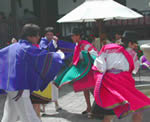 our
trip, and I blame it for the beginnings of a long bout of tourista.
We barely had time for a short rest back at the room before we were
collected by Victor and his friend Anabel. The walk took us out
of crowded downtown through some very beautiful older parts of town.
Victor's home was relatively large and contemporary, and six members
of his family - (we should have anticipated this) were present and
dressed as for church! Now you need to realize that Victor was the
only truly bi-lingual person there. Anabel and Victor's brother
Ivan spoke a smattering of English, and we all know the extent of
Don's Spanish (although he is making great strides), but if I thought
Victor was going to interpret I was mistaken. Teacher that he is,
he left me to present our story on my own. You could feel the room
swell with group support as I would reach for a word or a particular
verb conjugation! Victor's Aunt Maria, in turn, tried to tell us
about a big church chorale concert she was involved in, and when
it came clear that we had just missed it that very morning, she
gave us a personal reprise of her performance. This turned out to
be a quite lengthy recitation of a poem celebrating, I think, "my
beloved countryside". It was a very dramatic presentation,
and one didn't have to understand a word to be impressed! This was
followed by a round of sweet pink wine in tiny crystal glasses,
which was then followed by coffee with bread, biscuits and cheese
at the dining room table. Afterwards, after having heard all about
our Otavalo shopping spree, Victor's brother Ivan packed us into
his car to take us to San Antonio de Ibarra, a community famous
for its wood carvings, predominately of religious motifs. Only a
few shops were still open at this hour, and I hope we were not a
grave disappointment as we could not bring ourselves to buy one
more thing. All in all, it was one of the most special evenings
we have yet enjoyed in our travels. our
trip, and I blame it for the beginnings of a long bout of tourista.
We barely had time for a short rest back at the room before we were
collected by Victor and his friend Anabel. The walk took us out
of crowded downtown through some very beautiful older parts of town.
Victor's home was relatively large and contemporary, and six members
of his family - (we should have anticipated this) were present and
dressed as for church! Now you need to realize that Victor was the
only truly bi-lingual person there. Anabel and Victor's brother
Ivan spoke a smattering of English, and we all know the extent of
Don's Spanish (although he is making great strides), but if I thought
Victor was going to interpret I was mistaken. Teacher that he is,
he left me to present our story on my own. You could feel the room
swell with group support as I would reach for a word or a particular
verb conjugation! Victor's Aunt Maria, in turn, tried to tell us
about a big church chorale concert she was involved in, and when
it came clear that we had just missed it that very morning, she
gave us a personal reprise of her performance. This turned out to
be a quite lengthy recitation of a poem celebrating, I think, "my
beloved countryside". It was a very dramatic presentation,
and one didn't have to understand a word to be impressed! This was
followed by a round of sweet pink wine in tiny crystal glasses,
which was then followed by coffee with bread, biscuits and cheese
at the dining room table. Afterwards, after having heard all about
our Otavalo shopping spree, Victor's brother Ivan packed us into
his car to take us to San Antonio de Ibarra, a community famous
for its wood carvings, predominately of religious motifs. Only a
few shops were still open at this hour, and I hope we were not a
grave disappointment as we could not bring ourselves to buy one
more thing. All in all, it was one of the most special evenings
we have yet enjoyed in our travels.
The next day
we packed up to leave, but hopped off the bus one more time at the
cross-road for the community called Peguche. There was some enticing
talk about some Cascades in the guidebook, but our real motivation
for the extra effort was to get a special T-shirt Cindy was regretting
not buying from the Hostal Aya Huma, where she and Baker had gotten
married. It was a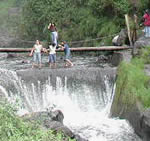 fortuitous stop, and, had we to do it all again, given that so much
of our great experience in Ibarra was entirely accidental, we would
plan to base ourselves here. As it was we stayed one night only,
but it is the first place we stayed that was not urban. The Hostal
Aya Huma , (email: ayahuma@imbanet.net; website (not working at
the moment) is ww.otavalo.com.ec/ayahuma .), owned by a Dutch-Ecuadorian
couple, is built straddling an abandoned railroad track that is
now a de facto road. The original family building is now the restaurant/bar,
which has a delightful chalet-like atmosphere and fire-place, as
well as sunny courtyard out front. The rooms are built down the
side of a wooded gorge filled with bird chatter, at the base of
which was a trickle of a stream and two hammocks. It was a little
pricier than our other hostels at $10pp/nite, but it was a place
you could happily spend a lot more time, as we later found out many
people do. We spent several hours reading in hammocks before lunchtime,
and then, in the afternoon took the walk to the Cascades. The path
led through park-like woodland (in fact it is a park) to a right
nice waterfall where many locals were enjoying the Sunday afternoon.
We branched off onto a side path hoping to gain an overlook, which
we found, but we had to negotiate a couple of cows with whom we
got into a shoving match. The next couple up actually got chased…delusions
of el toro!
fortuitous stop, and, had we to do it all again, given that so much
of our great experience in Ibarra was entirely accidental, we would
plan to base ourselves here. As it was we stayed one night only,
but it is the first place we stayed that was not urban. The Hostal
Aya Huma , (email: ayahuma@imbanet.net; website (not working at
the moment) is ww.otavalo.com.ec/ayahuma .), owned by a Dutch-Ecuadorian
couple, is built straddling an abandoned railroad track that is
now a de facto road. The original family building is now the restaurant/bar,
which has a delightful chalet-like atmosphere and fire-place, as
well as sunny courtyard out front. The rooms are built down the
side of a wooded gorge filled with bird chatter, at the base of
which was a trickle of a stream and two hammocks. It was a little
pricier than our other hostels at $10pp/nite, but it was a place
you could happily spend a lot more time, as we later found out many
people do. We spent several hours reading in hammocks before lunchtime,
and then, in the afternoon took the walk to the Cascades. The path
led through park-like woodland (in fact it is a park) to a right
nice waterfall where many locals were enjoying the Sunday afternoon.
We branched off onto a side path hoping to gain an overlook, which
we found, but we had to negotiate a couple of cows with whom we
got into a shoving match. The next couple up actually got chased…delusions
of el toro!
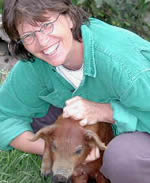 In
the evening we met Ali, a young Dutch woman on her last night of
a month-long stay. Ali had been there so long she had acquired a
pet piglet -Knorry - with wiry red hair, with whom she was spending
her last afternoon. Later, we joined her to sip wine on a stone
wall from which we could watch the winding up of a typical Otalaveño
Sunday -- the women and girls herding home the cows, the old men
staggering home under the influence of their once-a-week indulgence,
the boys in American garb, strutting their stuff -- all against
a backdrop of a fantastic evening light weaving through thick piles
of cloud over the beautiful valley. We moved the wine inside to
the fire place and a good dinner, which made a perfect cap to the
day before a deep quiet sleep under a pile of five Otavaleño
blankets. In
the evening we met Ali, a young Dutch woman on her last night of
a month-long stay. Ali had been there so long she had acquired a
pet piglet -Knorry - with wiry red hair, with whom she was spending
her last afternoon. Later, we joined her to sip wine on a stone
wall from which we could watch the winding up of a typical Otalaveño
Sunday -- the women and girls herding home the cows, the old men
staggering home under the influence of their once-a-week indulgence,
the boys in American garb, strutting their stuff -- all against
a backdrop of a fantastic evening light weaving through thick piles
of cloud over the beautiful valley. We moved the wine inside to
the fire place and a good dinner, which made a perfect cap to the
day before a deep quiet sleep under a pile of five Otavaleño
blankets.
We woke to a
parrot in the branches outside our window. After breakfast we took
a walk through town, where weekday life was already under way. Throughout
the town we could hear, if not see, the thunder of looms. We caught
a glimpse of an old man spinning wool at a wheel right out of Sleeping
Beauty. What we consider one our really special moments came went
we stumbled upon several young women making hammock yarn. They were
up a side road, across was strung wires at about 20'ft intervals.
Giant skeins of white yarn were dumped in a big basket, out of which
were drawn several strands which ran up through a wire hanger attached
to the eave of a house. One girl walked the "U" of the
strand over the wires some 300 feet up the road. The ends were attached
to an electric motor where we stood watching which then wound the
whole length into a single piece in about 60 seconds! This was pegged
over to the side until another length was wound, when the two were
spun together. Then one of the girls would wind up the whole into
a ball about the size of a basketball and the process would repeat
itself. Beneath the winding yarns, children and dogs played happily
in the dirt. This is not tourist stuff. This is real, everyday work.
We could have,
and would have, stayed on, except that we had had an email from
our young Peace Corps friend in Bahia relaying a message from our
Port Captain that he was unable to secure permission for us to sail
on to the Galapagos and that we would have to pursue it ourselves
in Quito. Fearing a bureaucratic snafu - and a totally illogical
one at that, since every cruiser we knew had sailed directly to
the Galapagos from Panama without any special permission - we hurried
back to Quito. Needlessly, as it turned out, as we determined that,
despite the Port Captain's beliefs, no permission was needed at
all for us to go. And, better luck, we found that out in one stop!
Still, once back in the big city, we found we were ready to go home.
A week away from the boat, without the boat being secure in at least
a marina, was a record for these two captains, and all the bus travel,
chilly climates, altitude, and foreign diet were starting to take
their toll on these tropical bodies. Home, James!
|